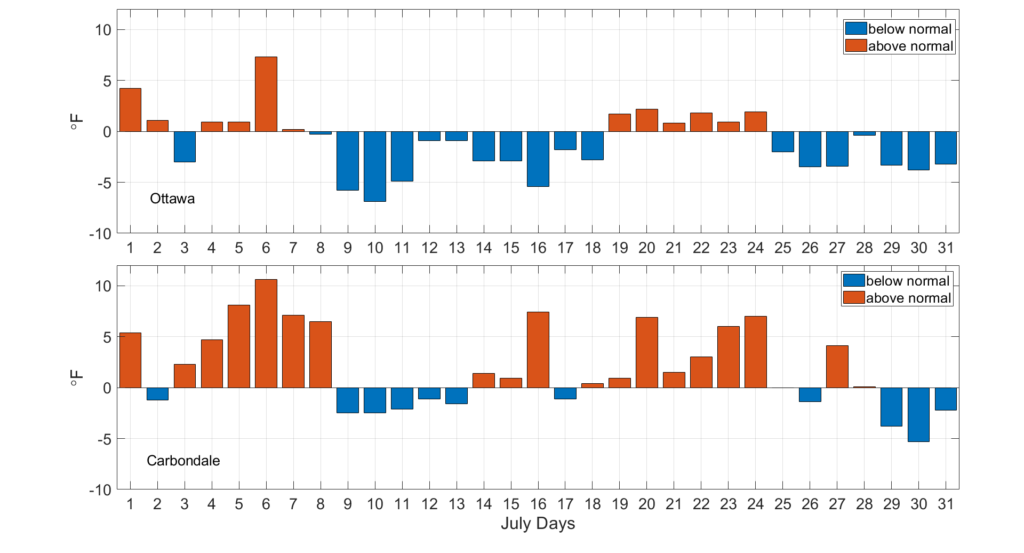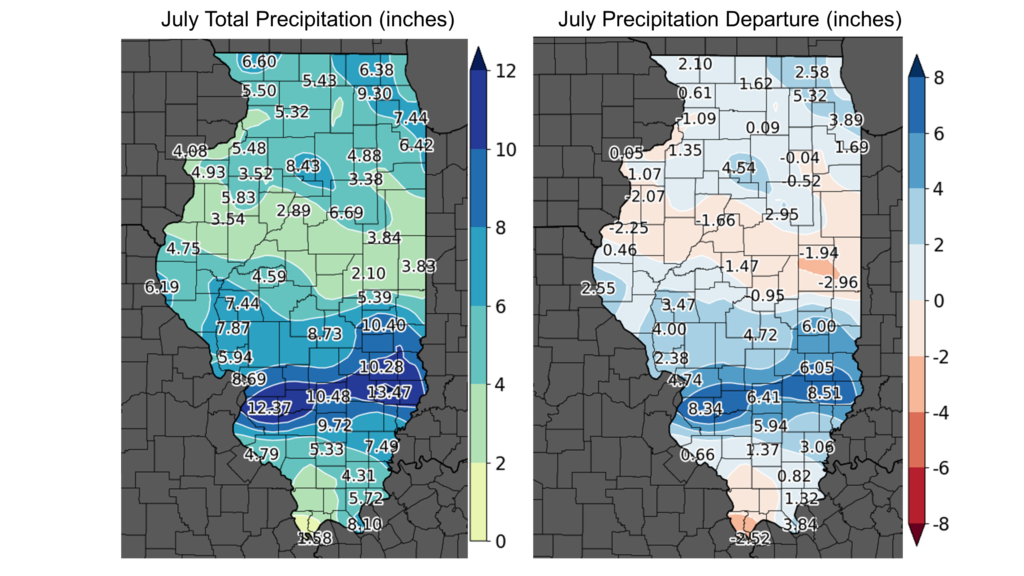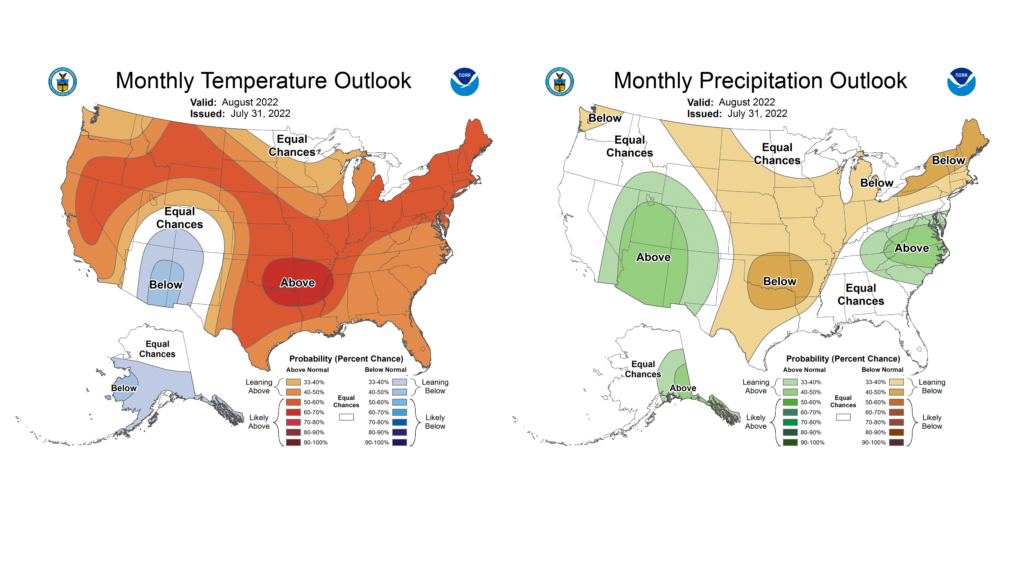The preliminary statewide average July temperature was 75.5 degrees, 0.1 degrees above the 1991–2020 average and tied for the 57th warmest on record going back to 1895. The preliminary statewide average total July precipitation was 5.69 inches, 1.63 inches above the 1991–2020 average and the 14th wettest on record statewide.
Data are provisional and may change slightly over time.
You’re Hot, Then You’re Cold
For the second consecutive year, much of Illinois experienced a cooler or near normal July following a very warm June. However, if you were in eastern or southern Illinois, your July was on the warm side. This contrast is shown in daily July temperature departures from normal in Ottawa and Carbondale (Figure 1). Most July days (19 out of 31) in Ottawa were between 1 and 6 degrees cooler than normal, while Carbondale only had 11 out of its 31 July days with below normal temperatures. Most of the state experienced significant heat waves in the first and third weeks of the month, with temperatures in Carbondale 10–12 degrees above normal.

Humidity was a bit lower than in the past few years in northern Illinois, but most of southern Illinois experienced yet another very humid July. Paducah, Kentucky had 10 days last month with a nighttime low temperature exceeding 75 degrees, and two days with low temperatures exceeding 80 degrees, the latter of which was the second highest frequency on record there.
We did get breaks from the heat in July, and the second week of the month saw temperatures that were 3 to 8 degrees below normal. Overall, July average temperatures ranged from the low 70s in far northern Illinois to around 80 degrees in southern Illinois. July was 1 to 3 degrees cooler than normal for most of northern Illinois, and 1 to 3 degrees warmer than normal in southern Illinois (Figure 2). The hottest point in the state last month was Cairo with an average July temperature of 82 degrees, and the coolest part of the state was Aurora with an average July temperature of 71 degrees.
Figure 2. Maps of (left) July average temperature and (right) July average temperature departures from normal. Map source: Iowa Environmental Mesonet, https://mesonet.agron.iastate.edu/.
Altogether, 2 daily high maximum temperature records were broken last month, and 15 daily high minimum temperature records were broken. Meanwhile, 7 daily low maximum temperatures were broken last year, including a 69-degree high temperature in Aurora on July 16. One daily low minimum temperature record was broken last month, a 52- degree low in Joliet on July 9.
The preliminary statewide average July temperature was 75.5 degrees, 0.1 degrees above the 1991–2020 average and tied for the 57th warmest on record going back to 1895.
July Rainfall: Too Much & Not Enough
July marks the transition between the wetter months between April and June and the relatively drier months of August through October. Precipitation in July tends to be on a more local scale, which can create disparities in rainfall totals. This past month though, that disparity was on steroids.
Multiple, intense rainfall events ran from northwest to southeast along and north of the Interstate 80 corridor and along the Interstate 64 corridor last month. This included incredibly intense rain in the St. Louis metro area on July 26. Between 6 and 13 inches of rain fell in less than 10 hours, with the highest totals just northwest of St. Louis city. On our side of the river, parts of Cahokia Heights and Belleville caught 7–8 inches of rain in less than eight hours, causing widespread and–in some places–catastrophic flooding (Figure 3). Based on state estimates of rainfall intensity probabilities, these totals in the Belleville area exceeded the estimated 0.2 percent annual exceedance, roughly a 1-in-500-year event. However, while this type of event has a 0.2 percent chance of happening in any given year by state estimates, rainfall intensity is increasing across Illinois, which complicates estimates of the likelihood of these types of events. More information on this event can be found on the St. Louis National Weather Service site: https://www.weather.gov/lsx/July262022Flooding.

In the same week as the St. Louis rain and flooding event, parts of Lake and Cook Counties in northeast Illinois experienced their own heavy rain event, causing damaging flooding in Lake Bluff. The Chicago National Weather Service office reports that between 4 and 6 inches of rain fell in less than 6 hours, which corresponds with a 0.5 percent annual exceedance probability or a 1-in-200-year event.
Both events in St. Louis and northeast Illinois followed similarly intense rain and flooding last year in Gibson City, Bloomington, and Seneca; flooding in Peoria, Belleville, and Chicago in 2020; and many parts of the state in 2019.
In addition to flooding in the Metro East, parts of Clay, Richland, and Lawrence Counties had between 12 and 14 inches of rain in July, which is 7 to 9 inches above normal (Figure 4). Olney in Richland County measured 11.5 inches last month, making it the second wettest July on the 120+ year record there (only behind 1958). More broadly, most areas outside of the Interstate 74 corridor and far southern Illinois were between 1 and 8 inches wetter than normal in July. Parts of the northwest Chicago suburbs were also very wet in July. Elgin measured 9.3 inches last month, making it the second wettest July on their 35+ year record, only behind 2017.
While rain was inundating the northern and south-central parts of the state, much of central Illinois from Monmouth to Danville remained somewhat to very dry. This area and parts of Alexander and Pulaski Counties in far southern Illinois were 1 to 3 inches drier than normal last month. In response, the US Drought Monitor introduced and expanded the severe to moderate drought classifications in east-central and far southern Illinois. Since the beginning of summer, most of Champaign and Vermilion Counties have had less than 60 percent of normal rainfall, and some parts of eastern Champaign County are 6 to 7 inches below normal on summer-to-date rainfall. June and July total rainfall in Champaign-Urbana is 3.23 inches, the ninth lowest total on record and the lowest since 2012. Extreme flooding in the St. Louis Metro East was contrasted last month by dead lawns and severely stressed crops in east-central Illinois.

The wettest point in the state in July was Olney in Richland County, with over 13 inches of rain. In contrast, Homer in Champaign County received just 1.28 inches in July. The preliminary statewide average total July precipitation was 5.69 inches, 1.63 inches above the 1991–2020 average and the 14th wettest on record statewide.
August and Early Fall Outlooks
For this State Climatologist, a cooler end to summer and early start to fall would be much appreciated. But, as it seems, mother nature has other plans. The latest outlook from the Climate Prediction Center leans warmer than normal throughout the state for August. The August precipitation outlook also leans drier than normal, albeit with a bit less certainty (Figure 5). It’s also worth giving a reminder that Atlantic tropical storm activity often ramps up in August and September, but tropical activity is difficult to consider in monthly to seasonal outlooks.

Meanwhile, outlooks for September through November keep the warmer and drier than normal lean in Illinois (Figure 6). Staying dry in September and October particularly could be conducive to an early jump start to harvest, but a lot remains between then and now, so we’ll want to see how outlooks and conditions progress through August.


